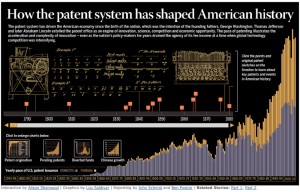 Interactive Graphic Illustrates How U.S. Patent System Has Driven American Economy notes:
Interactive Graphic Illustrates How U.S. Patent System Has Driven American Economy notes:
Last month, the Milwaukee Journal Sentinel published two articles documenting the current state of the U.S. patent system (see “The Milwaukee Journal Sentinel Gets It Right about Patents“). The authors of those pieces, John Schmid and Ben Poston, have now compiled an interactive graphic that shows how the U.S. patent system has shaped American history and innovation. The graphic contains a number of elements, including a timeline of key patents and significant events in American history, a comparison of domestic and foreign patents issued between 1790 and 2009, and charts showing the top countries and states in which U.S. patents originated, the number of pending applications between 1981 and 2009 and average application pendency between 1983 and 2008, fee diversion between 1992 and 2004, and rapid growth of the Chinese patent system between 1999 and 2008.
Some asked me if this proved patents do encourage innovation. But of course it does not. This proves absolutely nothing, in fact, except that there can still be growth despite state intervention such as intellectual monopoly grants. Correlation is not causation. I hope Obama doesn’t see this–I’m sure he could whip up a similar chart correlating growth over the last two centuries with, say, increasing taxes, increasing federal spending, increasing federal size/employment, increasing military size, increasing efficiency at mass murder, and so on.
Further, note the flaw in using China to prove the patents-drive-growth hypothesis: China’s economy has been growing for a good decade even though it has had and continues to have very mild and tepid IP laws. In fact, Chinese IP laws are gradually being reformed under pressure from the industrialized Western nations–no doubt to please large Western pharmaceutical, software, and other firms that stand to benefit from extending their Western-state-granted artificial monopolies to the growing Eastern economies (see my posts Russian Free Trade and Patents, IP Imperialism (Russia, Intellectual Property , and the WTO), Bush Wants More Jailed Citizens in Russia and China, and China, India like US Patent Reform). Do these intellectual monopolists really expect us to believe that China owes its recent growth to Disney and Big Pharma’s lobbying efforts?! Thank God the Western White Man saves the poor benighted Yellow Eastern man. What would they do without us? Who needs capitalism and increasing institutionalized respect for property rights–if you are a third world economy and want to grow, just let America strong-arm you to adopt their type of IP laws–along with their FDA regulations, antitrust law, and IRS. Give me a break.
Update: Interesting observation from Boldrin, M. and D. K. Levine [2011]: “What’s Intellectual Property Good for?,” Revue Economique, forthcoming:
A number of economic historians, Douglass North and his followers foremost among them, have argued that the great acceleration in innovation and productivity we associate with the Industrial Revolution was caused by the development of ways to protect the right of inventors, allowing them to profit from their innovations. Central among such ways was the attribution of patents to inventors, and their upholding either by Parliament or by the courts. Relative to the very poorly defined contractual rights of pre-seventeenth century Europe, plagued by royal and aristocratic abuses of property and contracts, there is no doubt that allowing entrepreneurs a well defined, if temporary, monopoly over the fruits of their inventive effort was a major step forward. Even monopolistic property is much better than a system that allows arbitrary seizure by the rich and powerful. This does not, however, contradict the claim according to which widespread and ever growing monopolistic rights are not as socially beneficial as well defined competitive property rights. To put it differently, about four centuries ago, as Western societies moved away from post-medieval absolutist regimes, the establishment of patents constituted a step forward for the creation of a system of property rights that favored entrepreneurship and free market interaction. By the force of the same reasoning, the abolition of patents and of the distortionary monopolistic rights they entail may well result, now, in an analogous boost to entrepreneurial effort and technological change. Once again, as a matter of available theories one cannot safely conclude one way or another.
See also Jeff Tucker’s post 2000 years in one chart.
[Mises]




You must log in to post a comment. Log in now.